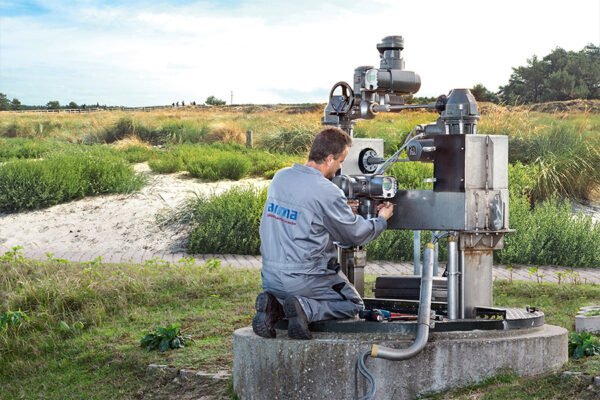If you work in the industrial sector, you’re likely familiar with motor operated valves (MOV). These essential components play a crucial role in regulating fluid and gas flow in many applications, including oil and gas production, chemical processing, and power generation. But how much do you really know about MOVs? To truly understand their function and optimize their performance, it’s essential to have a comprehensive understanding of how they work, how they’re controlled, and where they’re used.
That’s where MOV 101 comes in. This comprehensive guide will take you through everything you need to know about motor-operated valves, from their basic components to their applications in various industries. Whether you’re a seasoned professional or just starting out in the field, this guide will provide you with the knowledge you need to make informed decisions about your MOV systems and keep your operations running smoothly.
What is a Motor Operated Valve - MOV?
Motor Operated Valve (MOV) is an essential component in piping systems used to control the flow of fluids. MOV is a type of valve that uses an electric motor to open and close the valve. MOVs are commonly used in industrial applications where large valves need to be operated remotely or manual operation is impractical. MOVs are typically used in applications where the valve needs to be opened or closed quickly, such as in emergency shutdown systems or for controlling the flow of hazardous materials.
The motor used in a MOV can be either AC or DC, and the valve can be designed to operate either in a fail-safe or fail-close mode. Fail-safe means that the valve will automatically close in the event of a power failure, while fail-close means that the valve will remain in its current position.

What is the purpose of motor operated valve?
The purpose of a motor-operated valve is to control the flow of fluid or gas through a pipe or duct. This can be done manually, but in many cases, manual operation is not practical due to the size of the valve or location of the valve. In these cases, a MOV can be used to remotely control the valve, allowing it to be opened or closed quickly and easily. MOV is basically a valve automation component.
MOVs are commonly used in applications where the valve needs to be operated quickly, such as in emergency shutdown systems or for controlling the flow of hazardous materials. They are also used in applications where the valve needs to be operated remotely, such as in offshore oil and gas production.
Components of motor operated valves
The basic components of a motor-operated valve include the valve body, actuator, and motor. The valve body is the main component of the valve and is typically made of metal or plastic. The actuator is the component that controls the valve, and the motor is the component that powers the actuator.
The actuator is typically connected to the valve body by a stem or shaft, which allows the actuator to open and close the valve. The motor is typically connected to the actuator by a gear or belt, which allows the motor to transfer power to the actuator. The motor is typically equipped with a gearbox, which allows the motor to generate the torque required to operate the valve.
How motor operated valves work
Motor-operated valves work by using an electric motor to open and close the valve. When the motor is turned on, it rotates the actuator, which in turn rotates the valve stem or shaft. This causes the valve to open or close, depending on the direction of rotation.
MOVs can be designed to operate in a fail-safe or fail-close mode. In fail-safe mode, the valve will automatically close in the event of a power failure. In fail-close mode, the valve will remain in its current position.
Working principle of motor operated valves
The working principle of a motor operated valve is pretty simple. It consists of an electric motor, a gearbox, and a valve. The electric motor is connected to the gearbox, which in turn is connected to the valve stem. When the motor is activated, it rotates the gearbox, which drives the valve stem and opens or closes the valve. The motor stops when the valve reaches its desired position.

Types of motor operated valves and their functions
There are several types of motor-operated valves, including gate valves, globe valves, ball valves, and butterfly valves. Each type of valve has its own unique function and is used in different applications.
- Gate valves are typically used in applications where the valve needs to be opened or closed quickly, such as in emergency shutdown systems.
- Globe valves are typically used in applications where precise control of the flow of fluid or gas is required, such as in chemical processing or any other pressure/temperature sensitive applications.
- Ball valves are typically used in applications where the valve needs to be opened or closed quickly and where tight shut-off is required, such as in oil and gas production.
- Butterfly valves are typically used in applications where the valve needs to be operated remotely or where manual operation is not practical, such as in power generation.
Applications of motor operated valves
Motor-operated valves are used in a wide range of industries, including oil and gas production, chemical processing, power generation, water and wastewater treatment, and many others. In the oil and gas industry, MOVs are used to control the flow of oil and gas through pipelines and to shut down production in the event of an emergency. In the chemical processing industry, MOVs are used to control the flow of chemicals through processing equipment. In power generation, MOVs are used to control the flow of steam and water through turbines and generators.
Advantages of motor operated valves
There are several advantages to using motor-operated valves, including faster operation, greater precision, and remote operation. Because MOVs are operated by an electric motor, they can be opened and closed much more quickly than manually operated valves. This can be especially important in applications where speed is critical, such as in emergency shutdown systems. Additionally, because MOVs are operated by an electric motor, they can be controlled with greater precision than manually operated valves. This can be important in applications where precise control of the flow of fluid or gas is required. Finally, because MOVs can be remotely operated, they can be used in applications where manual operation is impractical, or the valve is located in a hard-to-reach location.
Comparison of motor operated valves with other types of valves
While motor-operated valves offer several advantages over manually-operated valves, they are not always the best choice for every application. Other types of valves, such as solenoid valves and pneumatic valves, may be more suitable for certain applications.
Solenoid valves are typically used in applications where the valve needs to be operated quickly and precisely, such as in fluid flow control in medical equipment. Pneumatic valves are typically used in applications where the valve needs to be operated remotely and where manual operation is impractical, such as in offshore oil and gas production.
Industry standards and regulations for motor operated valves
Because motor-operated valves are used in critical applications, such as emergency shutdown systems, they are subject to a variety of industry standards and regulations. These standards and regulations cover everything from the design and construction of the valve to its installation and maintenance.
One of the most important industry standards for motor-operated valves is the American Petroleum Institute (API) standard API 6D, which covers the design, manufacturing, inspection, and testing of pipeline valves. Other important standards for motor-operated valves include the American Society of Mechanical Engineers (ASME) standard B16.34, which covers the design and construction of valves, and the National Fire Protection Association (NFPA) standard 85, which covers the installation and maintenance of valves in power generation facilities.
Final words
Motor-operated valves are an essential component of valve automation systems used in various industrial applications, including oil and gas production, chemical processing, and power generation. By understanding the basic components of a MOV, how they work, and where they’re used, you can make informed decisions about the design, installation, and maintenance of your MOV systems.
MOVs provide precise control over the flow rate of fluids through the pipeline, require less maintenance than manual valves, and can be remotely controlled, making them ideal for hazardous environments. This article covers all the essential aspects of motor operated valves, including their types, working principles, advantages, and applications. If you are looking for an efficient and precise valve automation solution for your pipelines, motor operated valves could be the right choice.



